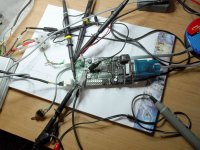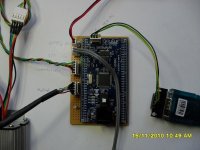Thanks Jeremy for the kind offer of the use of the analogue sensorless adaptor. I will bear it i mind if my current idea does not look like it will provide the desired results.
For the moment I feel I need to concentrate on developing the digital design that I have started.
I seems to work fairly well on my test bench here at home, but I need half a ton of equipment (computer, PIC programmer, logic analyser and oscilloscope) to make it perform, diagnose and configure it.
The challenge for me at the moment is to try and distill the unit into something that :
Will work reliably on its own,
I can replicate at a reasonable cost,
Is simple to install, configure and operate,
Will operate with more than one motor configuration (currently just designed around 14 pole motors)
I can put in a jiffy bag and post to the other side of the world,
Can be remoteley re-programed without the need for specialist expensive equipment,
Maybe its called production engineering, I dont know. What I do know is that it will likely take a bit of time.
But there is no better time to do it, the shity weather is-a-coming.....

Burtie



